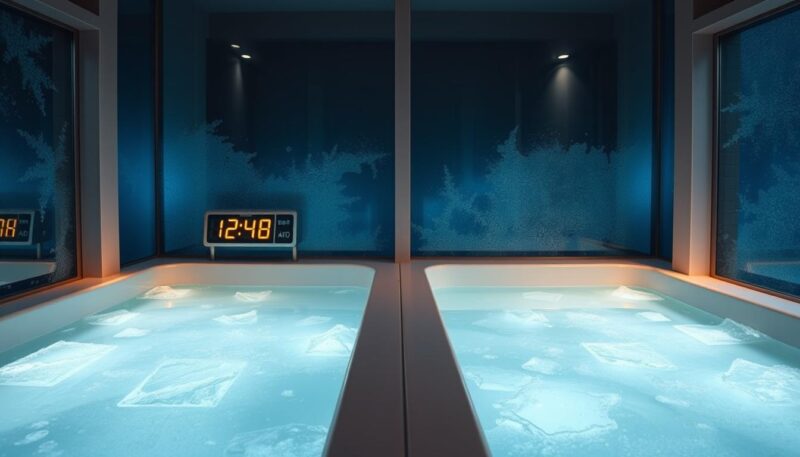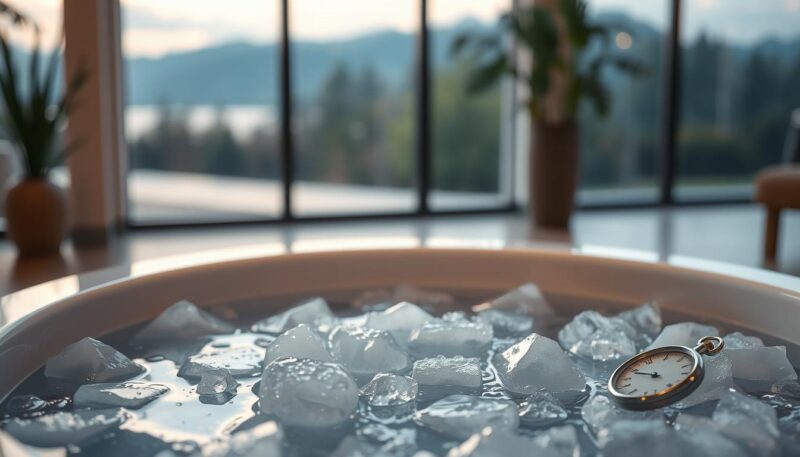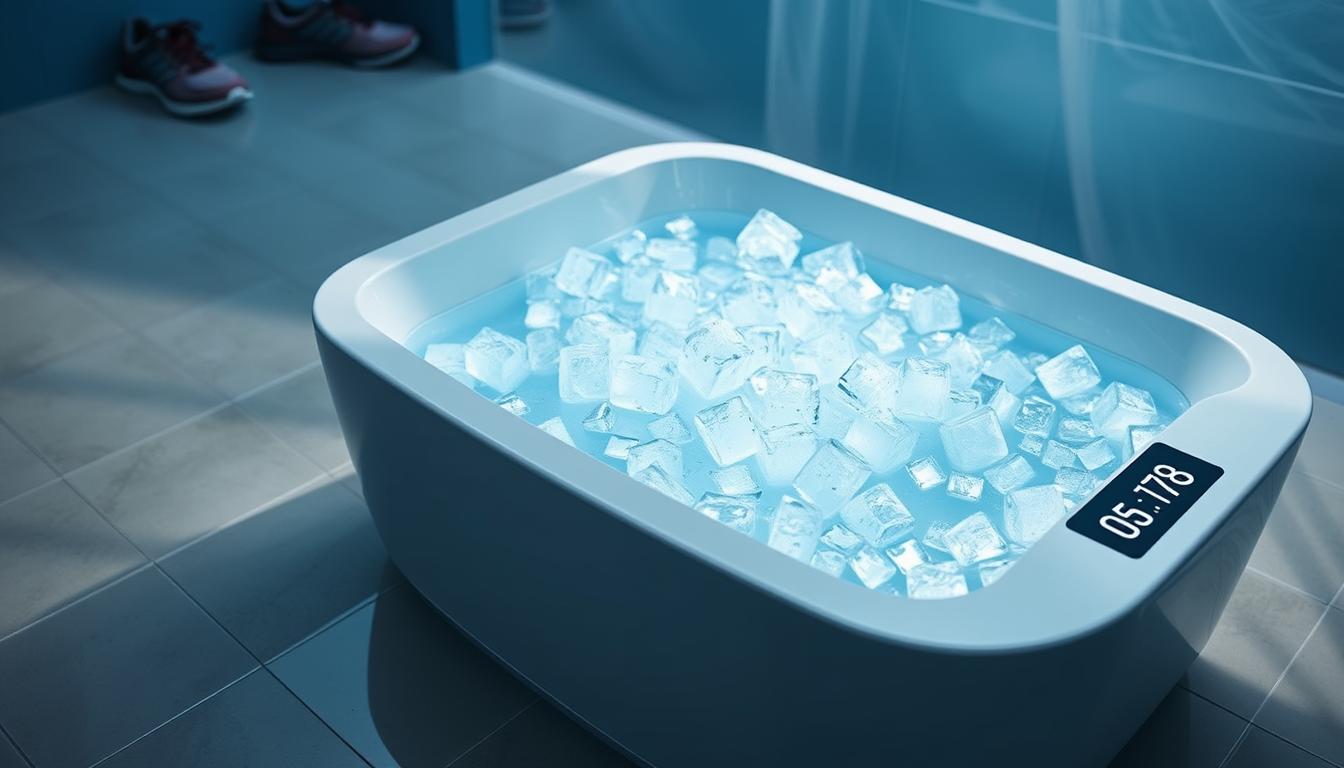When it comes to ice bath duration, understanding the optimal time in ice bath is crucial for maximizing benefits and minimizing risks. As an athlete or beginner, you’re likely interested in using ice baths to improve recovery, reduce muscle soreness, and enhance overall health. The optimal time in ice bath can vary depending on individual factors, including your level of experience and specific goals.
Ice baths have been shown to reduce muscle soreness and inflammation, improve recovery, and enhance mental well-being. For example, research has found that ice baths can increase dopamine levels, which can have a positive impact on your mood and overall sense of well-being. When considering ice bath for athletes, it’s essential to determine the ideal duration for staying in an ice bath to achieve maximum cryotherapy benefits without inducing excessive stress or risking frostbite or hypothermia.
To get the most out of your ice bath experience, you’ll want to consider factors such as water temperature, which is suggested to be about 10-15 degrees Celsius or 50-60 degrees Fahrenheit for optimal benefits. By understanding the optimal time in ice bath and following guidelines for ice bath for athletes, you can create a safe and effective routine that supports your health and wellness goals.
Understanding Ice Bath Basics and Safety Guidelines
As you consider incorporating ice baths into your routine, it’s essential to understand the basics and safety guidelines. A beginners ice bath guide typically recommends starting with short sessions and gradually increasing the duration as your body adapts. When it comes to ice bath time, medical advice suggests that beginners start with 2-5 minutes and gradually increase the time as needed.
Cold exposure therapy tips emphasize the importance of proper temperature and safety precautions. The recommended temperature range for ice baths is between 50-59°F. It’s crucial to avoid immersing yourself in water that’s too cold, as this can lead to discomfort and other concerns. According to research, daily or several times per week use of cold water therapy may enhance immune function, improve circulation, and support metabolic health.
What Temperature Should Your Ice Bath Be?
The ideal temperature for an ice bath is between 50-55°F. This temperature range allows for the benefits of cold therapy while minimizing the risk of discomfort or injury. It’s also important to note that ice bath time medical advice recommends gradually acclimating to the cold temperature to avoid shock or discomfort.
Essential Safety Precautions Before Starting
Before starting an ice bath routine, it’s essential to take certain safety precautions. This includes consulting with a healthcare provider if you have any medical conditions, such as cardiovascular issues. Additionally, it’s crucial to start with short sessions and gradually increase the duration as your body adapts. Cold exposure therapy tips also recommend listening to your body and stopping the session if you experience any discomfort or pain.
Who Should Avoid Ice Baths
Certain individuals should avoid ice baths or consult with a healthcare provider before starting a routine. This includes people with Raynaud’s disease, poor circulation, or other medical conditions that may be affected by cold therapy. A beginners ice bath guide should always prioritize safety and caution, and it’s essential to listen to your body and stop the session if you experience any discomfort or pain.
| Temperature Range | Recommended Duration | Benefits |
|---|---|---|
| 50-59°F | 2-5 minutes | Improved immune function, circulation, and metabolic health |
| 50-55°F | 10-15 minutes | Enhanced athletic performance, reduced muscle soreness, and improved recovery |
How Long to Stay in Ice Bath: Recommended Duration by Experience Level
When it comes to ice bath recovery duration, it’s essential to consider your experience level. Whether you’re a beginner or an advanced user, understanding the recommended duration is crucial for safe ice bath practices. For athletes, ice baths can be a game-changer for recovery, but it’s vital to follow guidelines to avoid any adverse effects.
As you prepare for your ice bath, consider the following factors that can impact your experience: age, fitness level, and injury status. Older adults may need less time in the ice bath due to decreased tolerance to cold water immersion, while individuals with higher fitness levels can tolerate longer ice baths. If you’re recovering from an injury, it’s essential to consult with a medical professional to determine the best approach.
First-Time Ice Bath Users: Starting Duration
For first-time users, it’s recommended to start with shorter durations, such as 5-10 minutes, and gradually increase the time as your body acclimates to the cold temperature. This allows you to get used to the sensation and reduce the risk of any adverse effects.
Advanced Users: Maximum Safe Duration
Advanced users can stay in the ice bath for longer periods, but it’s essential to be aware of the maximum safe duration. The general guideline is to stay in the ice bath for 10-15 minutes, but this can vary depending on your goals and the temperature of the water.
Athletic Performance Enhancement Timing
For athletes, the timing of ice baths can be crucial for enhancing performance. Research suggests that ice baths can improve recovery and reduce muscle soreness after exercise. The ideal time for ice baths can vary, but a common approach is to take an ice bath within 30-60 minutes after exercise.

| Experience Level | Recommended Duration |
|---|---|
| Beginner | 5-10 minutes |
| Advanced | 10-15 minutes |
| Athlete | Varies depending on goals and temperature |
Optimizing Your Ice Bath Experience for Different Goals
To get the most out of your ice bath experience, it’s essential to consider your specific goals, whether it’s recovery, relaxation, or athletic performance. The optimal time in ice bath and ice bath duration can vary significantly depending on your objectives. For example, if you’re looking to improve recovery, you may want to aim for a longer ice bath duration, while those seeking relaxation may prefer a shorter session.
Cold exposure therapy tips can also help you customize your experience. Research has shown that cold water immersion can have numerous benefits, including reducing inflammation and improving overall health. By adjusting the temperature and duration of your ice bath, you can tailor your experience to meet your specific needs.

Some key considerations for optimizing your ice bath experience include:
* Starting with shorter durations and gradually increasing the time as you adapt
* Adjusting the temperature to suit your goals, with colder temperatures often used for recovery and warmer temperatures for relaxation
* Incorporating complementary techniques, such as diaphragmatic breathing or visualization, to enhance the experience
By following these cold exposure therapy tips and considering your specific goals, you can create a personalized ice bath routine that helps you achieve your desired outcomes.
Conclusion: Creating Your Personal Ice Bath Protocol
By understanding the benefits and risks associated with ice baths, you can create a personal ice bath protocol that meets your specific needs and goals. This involves consulting with a medical professional, starting with gradual exposure to cold temperatures, and monitoring your body’s response to the ice bath. Experts recommend spending 10-15 minutes in an ice bath when the temperature ranges from 10-15°C (50-59°F), with shorter durations of 5-10 minutes for colder temperatures below 10°C. Highly trained athletes and older adults may require adjustments to the duration based on their tolerance levels.
When designing your ice bath protocol, consider your intended purpose, whether it’s for post-workout recovery or injury management. Additionally, research suggests that incorporating ice baths into your routine can have a positive impact on your mental well-being, helping to reduce symptoms of depression and anxiety. By following a safe and effective ice bath protocol, you can harness the power of cold therapy to support your overall health and athletic performance.
